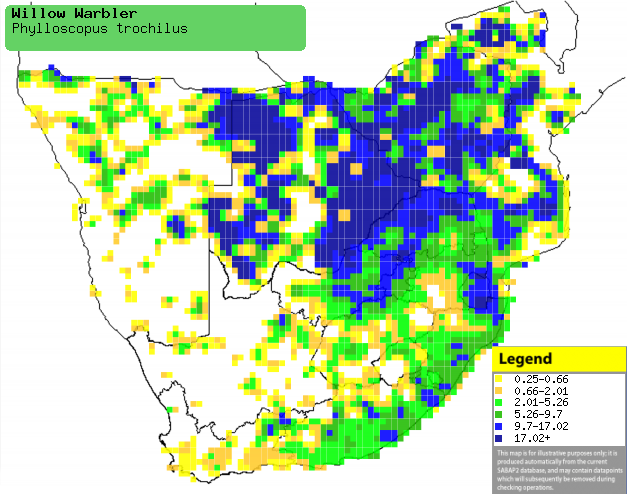|
Phylloscopus trochilus (Willow
warbler)
Hofsanger [Afrikaans]; Unothoyi [Xhosa]; Niini (generic
term for warblers and eremomelas) [Kwangali]; Pilipili-sa-mabelete [South
Sotho]; Timba (generic name for cisticolas and warblers) [Shona]; Acredula
[Dutch]; Pouillot fitis [French]; Fitis [German]; Felosa-musical
[Portuguese]
Life
> Eukaryotes >
Opisthokonta
> Metazoa (animals) >
Bilateria >
Deuterostomia > Chordata >
Craniata > Vertebrata (vertebrates) > Gnathostomata (jawed
vertebrates) > Teleostomi (teleost fish) > Osteichthyes (bony fish) > Class:
Sarcopterygii (lobe-finned
fish) > Stegocephalia (terrestrial
vertebrates) > Tetrapoda
(four-legged vertebrates) > Reptiliomorpha > Amniota >
Reptilia (reptiles) >
Romeriida > Diapsida > Archosauromorpha > Archosauria >
Dinosauria
(dinosaurs) > Saurischia > Theropoda (bipedal predatory dinosaurs) >
Coelurosauria > Maniraptora > Aves
(birds) >
Order: Passeriformes > Family: Sylviidae
> Genus: Phylloscopus
Distribution and habitat
Its breeding grounds stretch across northern Eurasia, from
Ireland east and north to the Russian Federation and Ukraine. In the
non-breeding season it heads south to sub-Saharan Africa, where it is common and
widespread across almost the entire continent, including southern Africa. Here
it occupies a variety of woodland habitats, including miombo (Brachystegia)
and other mixed woodland, as well as Acacia savanna, disturbed lowland
forest, riverine woodland, parks and gardens.
|
 |
|
Distribution of Willow warbler in southern Africa,
based on statistical smoothing of the records from first SA Bird Atlas
Project (©
Animal Demography unit, University of
Cape Town; smoothing by Birgit Erni and Francesca Little). Colours range
from dark blue (most common) through to yellow (least common).
See here for the latest distribution
from the SABAP2. |
Movements and migrations
It first gets to northern southern Africa in
late September, arriving progressively later further south in the
region, with South African arrivals peaking around December. It
departs throughout the region around March-April, with afew birds
staying until May.
Food
Its diet has not really been studied in Africa, however it
has been recorded eating small insects. It mainly forages in the canopy of trees
and shrubs, gleaning prey from leaves and branches and occasionally plucking an
insects from the ground.
Threats
Not threatened.
References
-
Hockey PAR, Dean WRJ and Ryan PG 2005. Roberts
- Birds of southern Africa, VIIth ed. The Trustees of the John Voelcker
Bird Book Fund, Cape Town.
-
Harrison, J.A., Allan, D.G., Underhill, L.G., Herremans, M.,
Tree. A.J., Parker, V. & Brown, C.J. (eds). 1997. The atlas of southern
African birds. Vol. 2: Passerines. BirdLife South Africa, Johannesburg.
|
